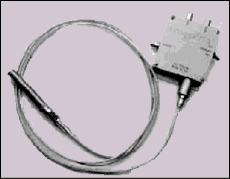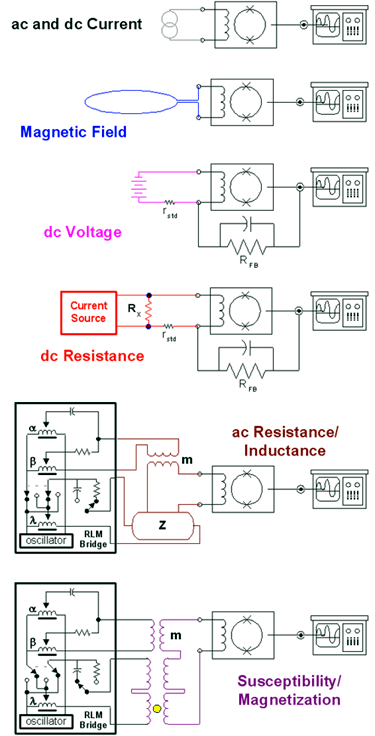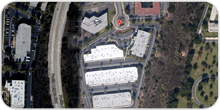 Tristan manufactures two basic SQUID probes (pdf) for general laboratory use. These probes are designed to be used while immersed in a liquid helium or nitrogen bath. A room temperature O-ring seal allows pumped dewar operation.
Tristan manufactures two basic SQUID probes (pdf) for general laboratory use. These probes are designed to be used while immersed in a liquid helium or nitrogen bath. A room temperature O-ring seal allows pumped dewar operation.
In all Tristan probes, construction materials are non-magnetic and carefully selected to minimize conduction of heat into the cryogenic bath. All probes are shielded against rf interference and other electrical transients that may affect the SQUID operation. Probes are available separately for upgrading older SQUID systems or for expanding the capabilities of a more recently purchased system.
- Model SP-1.5 Standard Cryogenic Cable (1.5 meter length)
- Model SP-2 Standard Cryogenic Cable (2 meter length)
- Model SP-C Standard Cryogenic Cable (custom length)
- Model RMP External Feedback Probe (1.5 meter length) with LSQ/20 sensor
- Model MFP Multi-Function Probe (1.5 meter length) with LSQ/20 sensor
Cryogenic Probes For The Laboratory
Features:
• Easy to install
• Multiple Measurement Capability
• Immersion Operation
Tristan manufactures two basic SQUID probes for general laboratory use. These probes are used to interface the SQUID sensors to the flux-locked loops and provide the basic capability for a variety of ultrasensitive measurements such as:
• Magnetic fields and field gradients
• Static magnetic moment and susceptibility
• Electric and magnetic fluctuations
• dc voltage and resistance
• Low frequency ac resistance and self-inductance
• Low frequency mutual inductance and susceptibility
Tristan’s cryogenic probes or cables provide a flexible transmission line running from room temperature to either 4 K or 77 K with plug-in connectors at each end. Without restrictions of a rigid probe, a variety of installation options are available.
In all Tristan probes, construction materials are non-magnetic and carefully selected to minimize conduction of heat into the cryogenic bath. All probes are shielded against rf interference and other electrical transients that may affect the SQUID operation. A room temperature O-ring seal allows pumped dewar operation. Probes are available separately for upgrading older SQUID systems or for expanding the capabilities of a more recently purchased system.
The Model SP Cryogenic Cable is the probe of choice for simple current and magnetic field measurements. It is available in two standard lengths (1.5 meter and 2 meter) as well as custom lengths.
 The Model MFP Multi-Function Probe is the most versatile LTS SQUID probe offered. It combines full picovoltmeter, magnetometer, and ac bridge capabilities in a compact, easy-to-use design. The Model MFP can be used in any of the configurations shown in the figure below.
The Model MFP Multi-Function Probe is the most versatile LTS SQUID probe offered. It combines full picovoltmeter, magnetometer, and ac bridge capabilities in a compact, easy-to-use design. The Model MFP can be used in any of the configurations shown in the figure below.
The MFP probe includes additional room temperature circuitry located in a vacuum sealed housing. The Model MFP uses a longer LTS SQUID sensor housing (Model LSQ/20M) to accommodate a small cryogenic terminal board with the resistance and mutual inductance standards required for voltage and impedance measurements. Rewiring of the probe to change its function is easily accomplished by moving a few jumper wires located on the terminal board. Its great versatility makes this the recommended probe when a variety of applications are required.
Technical Features of MFP:
• Model MFP: Working Temperature: 0 – 7 K (LSQ/20 sensor only)
• Standard Resistor: 30 µW (nominal)
• Standard Mutual Inductance: 0.6 µH (nominal)
• System Voltage Gain: 108 (nominal)
• Input Impedance: R = 10 Ω, capacitive at non-zero frequencies with Z ~= 1/10 j Ω
• Current Leads: rf decoupled floating pair, maximum current 0.5 Amperes
The Model SP Cryogenic Cable provides a flexible transmission line running from room temperature to either 4 K or 77 K with plug-in connectors at each end. Without restrictions of a rigid probe, a variety of installation options are available.
The Model MFP Probe is the most versatile LTS SQUID probe offered. It combines full picovoltmeter, magnetometer, and ac bridge capabilities in a compact, easy-to-use design. The probe itself is similar in design to the Model SP with a few important additions. These include additional room temperature circuitry located in a vacuum sealed housing. Also, the Model MFP accommodates a small cryogenic terminal board with the resistance and mutual inductance standards required for voltage and impedance measurements. Rewiring of the probe to change its function is easily accomplished by moving a few jumper wires located on the terminal board. Its great versatility makes this the recommended probe when a variety of applications is required. Some of the measurement configurations of the Model MFP are shown below.
Model MFP Multi-Function Probe configurations
The Model MFP Multi-function SQUID probe performs a variety of ultra-sensitive electromagnetic measurements:
• Magnetic fields and gradients with 10-12 T sensitivity.
• dc and low-frequency ac voltage with 10-13 V resolution.
• dc and low-frequency ac resistance with 10-11 Ω resolution.
• Low-frequency self and mutual inductance with 10-12 H resolution.
• Static and low-frequency ac magnetic moment and susceptibility (sensitivity depends on experimental design, but a properly designed system can resolve <10-12 emu).

Although the cryogenic portion of the probe must remain below about 7 K, there are no fundamental restrictions on the temperature of the sample. However, thermal noise from the sample and any leads connected to it will usually dominate the system noise level for non-cryogenic samples. The measurement of magnetic susceptibility is an important exception to this, since the sample can be thermally isolated from the detection coils.
General Characteristics
The Model MFP probe comprises a small, room-temperature enclosure, a flexible transmission line, and a shielded, cryogenic enclosure. The room-temperature enclosure is used to attach all necessary electrical leads and contains suitable filters to minimize problems from interfering signals. One connector on this enclosure interfaces to Tristan’s iMAG® SQUID electronics which are required for operation of the probe. The other connectors are used to interface to various ancillary equipment required by your specific measurement.
The 1.5 m long, non-magnetic, flexible transmission line allows use in most helium cryostats, but other lengths are optionally available. Spare, shielded filtered leads in this transmission line accommodate the requirements of most experiments. Vacuum-tight feedthroughs allow use in a pumped helium cryostat. A vacuum tight, room temperature O-ring seal can be made on the 16 mm (0.625″) diameter surface (see enclosed drawing).
The shielded enclosure at the lower end of the probe houses the dc SQUID sensor and other components needed for the various measurements. The superconducting shield can be easily removed to gain access to the terminal board inside. All cryogenic connections are made to this terminal board.
Magnetic Field Measurements
To measure magnetic fields or gradients, pick up coils may be connected directly to the SQUID sensor. In this mode, the SQUID sensor acts as a sensitive current detector having a superconducting input with an inductance of ~2 µH. The effective input current noise is guaranteed to be less than 7 x 10-13 A/√Hz, which is equivalent to an energy resolution of 5 x 10-31 J/Hz. A 4 turn, 2 cm diameter superconducting loop connected to this input provides a magnetic field resolution of 2 fT/√Hz. Other coil configurations can be used to make ultra-sensitive measurements of susceptibility, field gradient, or any other parameter which generates a low-frequency (dc to 50 kHz) magnetic field.
Low-Frequency Voltage and Resistance Measurements
The Model MFP probe can be configured to measure low-frequency voltage changes by installing jumpers inside the shielded enclosure at the bottom of the probe. When so configured, the system functions as a cryogenic, voltage-measuring amplifier with a gain of 108, an input resistance of 10 ohm, and an rms noise of less that 10-13 V/√Hz. The amplified output signal may be measured using a DVM or any other voltage measuring device. No other ancillary electronics are required to measure voltages.
The probe can also be configured to measure very small resistance. To facilitate four-terminal measurements, a pair of shielded and rf-filtered leads capable of carrying 0.5 A are provided. These may be connected to a suitable, adjustable current source via the room-temperature enclosure. Low-temperature connections to your unknown resistor are made at the terminal board in the shielded enclosure.
Typical applications for low-frequency voltage or resistance measurements include:
- Low-temperature thermopower measurements
- Superconducting transition measurements
- Infrared detection using low-impedance bolometers
- Resistivity of high-purity metals
Although the cryogenic portion of the probe must be kept below about 7 Kelvin, the sample may be operated at any temperature. When a voltage source having a resistance Rs (including leads) and temperature Ts is measured, and the product RsTs is larger than about 10-4 Ω-K, thermal noise from the sample will dominate and is given by V = √4kRsTs (Vrms).
ac Impedance Measurements
The Model MFP probe can also be configured to serve as a direct replacement for S.H.E. Corporations’ Model RMP and MFP SQUID probes to make low-frequency, ac impedance measurements. This mode of operation requires an ac Impedance Bridge or an S.H.E. RBU Bridge or equivalent.


